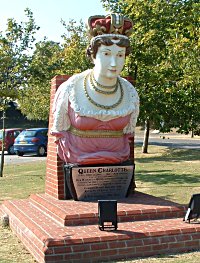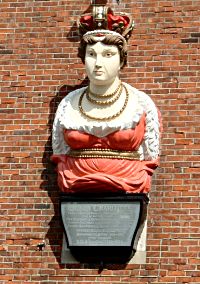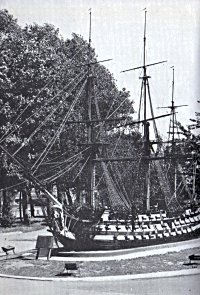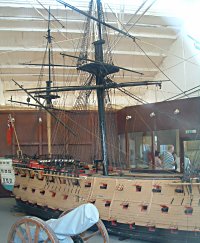Location
On the lawns opposite the entrance to HMS Excellent. Formerly, high on the side wall of a building to the North-East of the Officers Mess (2004).

Figurehead (2004)

Ship Model (c1930)

Ship Model (2007)

QUEEN CHARLOTTE
1768-1800 100 GUNS 1810-1892 104 GUNS
LINE OF BATTLESHIP NAMED AFTER
HER MAJESTY THE QUEEN CONSORT OF GEORGE III
FLAGSHIP OF "EARL HOWE" ON THE GLORIOUS FIRST OF JUNE 1794
FLAGSHIP OF "LORD EXMOUTH" AT THE BOMBARDMENT OF ALGIERS 1815
GUNNERY SCHOOL SHIP 1859-1890
REPLACING THE "BOYNE" 1834-1859
WHICH SUCCEEDED
H.M.S. EXCELLENT 1830-1834
Further Information
The first Queen Charlotte was built at Chatham in 1790 to the design of E. Huntley. She was 190ft long and 52ft 5½in in breadth. She carried an armament of 100 guns and cost £54,648. She was commissioned in 1793 when Admiral Earl Howe hoisted his Flag in her with Sir Roger Curtis as Senior Captain. A year later Howe was to write his name into history on the Glorious First of June accompanied by the Queen Charlotte.
In 1800, as flagship to Lord Keith, the Queen Charlotte arrived in Leghorn and proceeded to reconnoitre the island of Capraja, then held by the French. On 17th March at 6am she was seen to be on fire and despite the heroic efforts of her crew she blew up at 11am and turned over with the loss of 673 officers and men.
The second Queen Charlotte was laid down at Deptford in 1803 and launched in 1810. She was built to the same design as her predecessor, except that she now had an armament of 108 guns. In 1813 she was commissioned with Robert Jackson as her first Captain. Little of consequence happened to the ship until 1816 when she was sent to Algiers under the Flag of Lord Exmouth to rescue the European hostages that had been captured by North African pirates.
The Queen Charlotte returned to Portsmouth where her station was described as 'Spithead'. She remained there, largely inactive, until 1859 when she briefly regained her role as Flagship to Vice-Admiral Edward Harvey. This lasted for less than a year, for on December 31st 1859 she took over from the former HMS Boyne as HMS Excellent, a role she perfomed until 1891 when the Gunnery School finally transferred to Whale Island.
A replica of the second Queen Charlotte (see photo) was placed at the entrance to Excellent in the 1930s but it suffered considerable damage in the storms of 1987 and was removed to store in the Dockyard. It was later returned to Excellent where it resides in the same building as the Gun Carriage.
